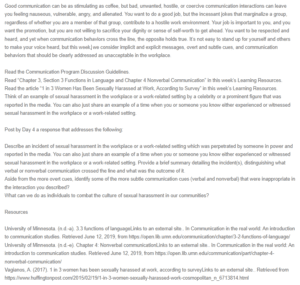When Communication Behaviors Cross the Line
One well-publicized case of workplace sexual harassment featured Harvey Weinstein, a well-known personality in the entertainment sector. Weinstein was accused by multiple women, including actresses Ashley Judd and Rose McGowan, of a decades-long history of sexual harassment and abuse (Dawson & Mäkelä, 2022). The complaints included explicit verbal harassment as well as nonverbal indicators such as unwelcome advances and forceful behavior. The resolution of these charges was a watershed moment in the #MeToo movement, as Weinstein was found guilty of sexual assault and rape and sentenced to 23 years in jail.
In the instance of Harvey Weinstein, there were other subtle communication signs that were exceedingly improper in addition to the overt sexual harassment. These included veiled threats to the victims’ careers, insinuations of industry norms requiring cooperation, and the manipulation of power relations to instill fear and quiet. His predatory behavior included nonverbal signs such as invasive physical proximity, unwanted caressing, and manipulative body language. These subtler forms of communication were crucial in perpetuating the harassment and contributing to victims’ reluctance to come forward, emphasizing the importance of recognizing and addressing not only the overt but also the more insidious communication behaviors that cross the line in cases of workplace sexual harassment.
Individuals can take numerous proactive efforts to address the culture of sexual harassment in the community. To begin, it is critical to increase awareness and educate oneself and others about what constitutes sexual harassment, as well as the value of consent and respect. Second, we can encourage open discourse and the establishment of safe places in which people can report incidences without fear of retaliation. Third, we can encourage survivors and trust their stories because validation and empathy are critical. Individuals must be held accountable for their conduct, and inappropriate behavior, no matter how subtle, will not be tolerated (Mattheis et al., 2022). Finally, cultivating a culture of respect, equality, and consent demands active participation, awareness, and a commitment to establishing situations in which all individuals are treated with dignity and fairness.
References
Dawson, P., & Mäkelä, M. (2022). The Routledge companion to narrative theory. Taylor & Francis.
Mattheis, A., Marín-Spiotta, E., Nandihalli, S., Schneider, B., & Barnes, R. T. (2022). “Maybe this is just not the place for me:” Gender harassment and discrimination in the geosciences. PLOS ONE, 17(5), e0268562. https://doi.org/10.1371/journal.pone.0268562
ORDER A PLAGIARISM-FREE PAPER HERE
We’ll write everything from scratch
Question

When Communication Behaviors Cross the Line
Good communication can be as stimulating as coffee, but bad, unwanted, hostile, or coercive communication interactions can leave you feeling nauseous, vulnerable, angry, and alienated. You want to do a good job, but the incessant jokes that marginalize a group, regardless of whether you are a member of that group, contribute to a hostile work environment. Your job is important to you, and you want the promotion, but you are not willing to sacrifice your dignity or sense of self-worth to get ahead. You want to be respected and heard, and yet when communication behaviors cross the line, the opposite holds true. It’s not easy to stand up for yourself and others to make your voice heard, but this week, we consider implicit and explicit messages, overt and subtle cues, and communication behaviors that should be clearly addressed as unacceptable in the workplace.
Read the Communication Program Discussion Guidelines.
Read “Chapter 3, Section 3 Functions in Language and Chapter 4 Nonverbal Communication” in this week’s Learning Resources.
Read the article “1 in 3 Women Has Been Sexually Harassed at Work, According to Survey” in this week’s Learning Resources.
Think of an example of sexual harassment in the workplace or a work-related setting by a celebrity or a prominent figure that was reported in the media. You can also just share an example of a time when you or someone you know either experienced or witnessed sexual harassment in the workplace or a work-related setting.
Post by Day 4 a response that addresses the following:
Describe an incident of sexual harassment in the workplace or a work-related setting which was perpetrated by someone in power and reported in the media. You can also just share an example of a time when you or someone you know either experienced or witnessed sexual harassment in the workplace or a work-related setting. Provide a brief summary detailing the incident(s), distinguishing what verbal or nonverbal communication crossed the line and what was the outcome of it.
Aside from the more overt cues, identify some of the more subtle communication cues (verbal and nonverbal) that were inappropriate in the interaction you described?
What can we do as individuals to combat the culture of sexual harassment in our communities?
Resources
University of Minnesota. (n.d.-a). 3.3 functions of languageLinks to an external site.. In Communication in the real world: An introduction to communication studies. Retrieved June 12, 2019, from https://open.lib.umn.edu/communication/chapter/3-2-functions-of-language/
University of Minnesota. (n.d.-e). Chapter 4: Nonverbal communicationLinks to an external site.. In Communication in the real world: An introduction to communication studies. Retrieved June 12, 2019, from https://open.lib.umn.edu/communication/part/chapter-4-nonverbal-communication/
Vagianos, A. (2017). 1 in 3 women has been sexually harassed at work, according to surveyLinks to an external site.. Retrieved from https://www.huffingtonpost.com/2015/02/19/1-in-3-women-sexually-harassed-work-cosmopolitan_n_6713814.html

